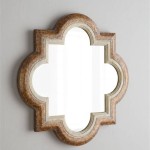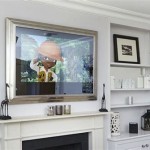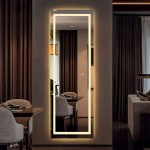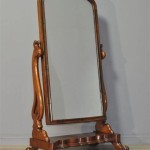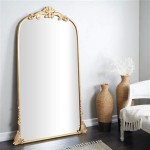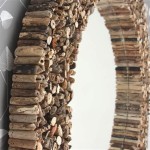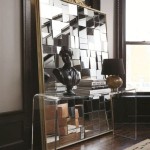How To Hang An Old Mirror Frame
Hanging an antique or vintage mirror frame, whether it retains its original glass or serves as a decorative frame for artwork, requires careful consideration due to its age and potential fragility. Understanding proper hanging techniques ensures both the preservation of the frame and secure wall display. This guide outlines methods for safely and effectively hanging an old mirror frame.
Assessing the Frame
Before attempting to hang the frame, a thorough assessment is crucial. Examine the frame's material, construction, and existing hanging hardware. Look for any signs of damage, weakness, or previous repairs. The frame's weight and size are also critical factors in determining appropriate hanging methods.
Reinforcing the Frame (If Necessary)
Older frames might require reinforcement, especially if the existing hanging hardware is loose or damaged. Loose joints can be carefully reglued with wood glue suitable for antique furniture. Small corner braces or mending plates can provide added stability at weak points. Consult with a professional frame restorer for significant structural damage or valuable antique frames.
Choosing Appropriate Hanging Hardware
The appropriate hanging hardware depends on the frame's weight, size, and wall material. For lighter frames, D-rings or sawtooth hangers are often sufficient. Heavier frames require more robust solutions such as wire hangers attached with eye screws or heavy-duty picture hooks rated for the frame's weight. For especially heavy frames, consider using two hanging points for added stability. Ensure the chosen hardware complements the frame's style and doesn't detract from its aesthetic appeal.
Selecting the Right Wall Fasteners
The wall material dictates the type of fastener required. Drywall requires specific anchors like plastic expansion anchors or self-drilling drywall anchors. For plaster walls, it is often best to locate and use existing wall studs. Masonry walls require specialized masonry screws or anchors. Always choose fasteners rated to support a weight significantly exceeding that of the framed mirror.
Marking the Hanging Position
Accurate measurement and marking are essential for a visually appealing and secure hanging. Determine the desired height for the frame's center point. Measure the distance between the top edge of the frame and the hanging hardware. Transfer these measurements to the wall, marking the points where the wall fasteners will be installed. Using a level ensures the markings are perfectly horizontal.
Installing Wall Fasteners and Hanging the Frame
Carefully install the chosen wall fasteners according to the manufacturer's instructions. Ensure the fasteners are inserted securely into the wall. For wire hangers, use a wire tightener to remove slack and create a taut hanging line. Gently lift the frame and hang it on the installed fasteners. Use a level to verify the frame is hanging straight and adjust as needed. If the frame feels unstable, re-evaluate the hanging hardware and wall fasteners, opting for more heavy-duty solutions.
Using Specialized Hanging Systems
For particularly large, heavy, or valuable antique mirror frames, consider using specialized hanging systems. These systems, like French cleats or security picture hanging hardware, offer enhanced stability and security. French cleats utilize interlocking wooden or metal brackets, distributing weight evenly along the wall. Security hanging hardware features locking mechanisms that prevent accidental displacement or theft. These systems are particularly beneficial for frames in high-traffic areas or earthquake-prone regions.
Protecting the Frame and Wall
To prevent scratches on both the frame and the wall, consider applying small felt or rubber bumpers to the back of the frame where it contacts the wall. These bumpers also provide a small gap for air circulation, minimizing the risk of moisture buildup behind the frame. For extremely valuable or delicate frames, consult with a professional art installer for specialized protective measures.
Documenting the Process
When working with antique or vintage frames, documenting the hanging process is a recommended practice. Photograph the frame's condition, including any existing hardware or repairs, before starting. Note the type of hanging hardware and wall fasteners used. Keep these records for future reference, especially if the frame needs to be moved or re-hung.

How To Hang A Mirror Or Picture On Fragile Wall

Loving An Old Mirror Edith Evelyn

How To Hang This Heavy Mirror And What Is Hanging Method Called Hometalk
:max_bytes(150000):strip_icc()/alahome1-a879d69e31be4a9a9ae522028c12926d.jpg?strip=all)
20 Diy Mirror Frame Ideas To Inspire Your Next Project

Upcycling That Old Mirror And Frame Into A New One

How To Build A Diy Frame Hang Over Bathroom Mirror Love Our Real Life

How To Hang A Heavy Mirror Ask This Old House

How To Decorate A Mirror 12 Steps With Pictures Wikihow

How To Frame Out That Builder Basic Bathroom Mirror For 20 Or Less

How To Install A Mirror Without Frame Merrypad

